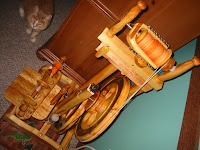
Spin-Dizzies were hand crafted by Kat Walton, a spinner and weaver.
The Bellwether is proud to be Kat's retail outlet for her fine spindles. These spindles are Turkish- or Russian-style, with two oblong, overlapping whorl pieces. The photo shows bottom whorl Spin-Dizzies in each size: the Standard (no longer available), Traveller, and Laceweight. These are all shown as bottom whorls.
The Standard and Laceweight also were made in top whorl arrangements; the laceweight even comes as a convertible, with the shaft shaped so the whorl can be closer to the hook or further from the bottom-whorl shaft.
The shaft on the Spin-Dizzies is round; a hand-carved crochet-hook atops the top whorls, and an indendation all the way around is near the end of the bottom whorl shaft. For the Traveller and Standard, the shaft is squared toward the bottom to hold the whorl pieces in place. The Laceweight is not squared, so it needs a leader tied and wrapped several times to hold the whorls in place at the start of spindling.
The laceweight weighs from as little as 3 grams to about 10-12 grams (in Ebony top whorl). It is not for the beginner spindler, being too light for all but the finest spinning. This is a great spindle to learn to spin cobweb weight on. In fact, my personal introduction to Spin-Dizzies was Kat showing up on my doorstep (literally!) with a 5 gram bottom whorl after I'd posted on Spindlitis that I thought I might try to spin cobweb weight yarn next. Wow!
The Traveler is sized for ease of transport and great spindling. It is only available as a bottom whorl, and is great for traveling. Great for spinning sock yarns, these weigh from 1/2 to just over 1 ounce.

Kat recommends having more than one set of whorls per spindle, especially with the laceweight spin-dizzies, so you can save one spinning project until you have a second spindle-full to ply with. I'd note also the laceweight spin-dizzies won't usually ply what they spin, as they are sooo light. But any regular spindle will ply their singles just fine. Yarn is much tougher than roving, and can take quite a bit of weight from a plying spindle. This picture shows two laceweights, top and bottom whorl style, with cotton spinning in progress on them.
As with Turkish spindles, you wrap the yarn around the arms as you go; use your favorite Turkish wrap -- these often get discussed on
spindlers -- my favorite is simply to make an "X" at 45 degrees to the X of the arms themselves. Then I end up with a fairly round ball, and if I can fish out the beginning end from the center (bright red leader yarn is great for enabling this!) I can ply from both ends right back onto the spindle, with my Traveler.
Kat is no longer making Spin-Dizzies due to her health; she is teaching her son to make them, and we both have high hopes. The first batch of whorls from him was quite nicely done; next, he's going to work on Travelers. But he will be going to college, so it is likely his wood-working will be intermittent for a few years.
My Spin-Dizzy projects to date include several cotton skeins on the laceweights, used in my undulating twill project (
still underway); and many a skein on a Traveler, used in various knitting projects and also for yarn for my mother (who loves to knit with handspun!). I've been eyeing my lovely Macassar Ebony Traveller lately, to do some more spindling-for-socks. Time to start a new project! LOL!
 Let's just call February the month of the WIP. Last month's completed UFO, the Jacob spinning, is now firmly "WIP" with about 3 sessions on the needles, about 3-4 inches more of tote-dom added on.
Let's just call February the month of the WIP. Last month's completed UFO, the Jacob spinning, is now firmly "WIP" with about 3 sessions on the needles, about 3-4 inches more of tote-dom added on. The superwash Merino from Madrona Fiber Arts Festival is all spun up (singles, sigh) and in the plying. Gorgeous bright-bright orange with some lightening from the whites.
The superwash Merino from Madrona Fiber Arts Festival is all spun up (singles, sigh) and in the plying. Gorgeous bright-bright orange with some lightening from the whites. A little beaded knitted bracelet is underway, a little over half done.
A little beaded knitted bracelet is underway, a little over half done.






























